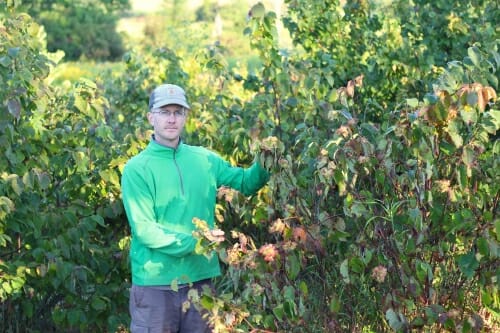May 9, 2019Experts advance crops for profitability
On a field in western Madison, Wisconsin, where cornfields sprout houses, Amaya Atucha and three graduate students are giving a buzzcut to some experimental grape vines. As the sun plays hide and seek with clouds above the West Madison Agricultural Research Station, the group shortens each cane branching off the main vine to just two buds.
As a yard of cane, severed, drops to the ground, Atucha explains that when sunlight can strike the grape clusters, acidity will decline. At the same time, the ruby-red color so desired in wine will gain depth.
It’s easy to pity the vines, as the canes pile up beneath them, but vineyards are not planted to grow wood. The goal is grapes – fresh, abundant, and full of the chemistry that makes great wine, said Atucha, an assistant professor of horticulture at UW–Madison.
Atucha is also the Division of Extension’s expert advisor for fruit farmers statewide.
At West Madison, and other sites around the state, Atucha does practical research on new varieties. She studies pruning, timing and other cultural techniques to increase profitability of grape production in the state.
Atucha’s grape project is one of several at UW–Madison’s Division of Extension that focuses on small, new or reintroduced crops that could support the bottom line in a state battered by low prices for corn, soybean and milk.
“Wisconsin’s agriculture is changing in many ways,” said Karl Martin, Extension dean and director. “Extension educators are working with farmers to adapt to changes by exploring innovative alternatives to traditional crops.”
Extension Buffalo County Extension agriculture agent Carl Duley and others from the University are orchestrating the return of a classic Wisconsin crop: hops, the bittering agent in beer.


“UW Extension agents and specialists work with growers to identify problems, challenges and opportunities to improve hops production in Wisconsin through workshops, field days, one-on-one visits and on-farm research trials and demonstrations,” said Duley.
One ongoing focus, in collaboration with hops growers near Tomah, Rosholt and Waterloo, concerns different methods for applying nitrogen to two varieties of hops.
J
Wisconsin also hosts a long campaign to introduce hazelnuts, a crop that can take almost 10 years to reach profitability. Most of the U.S. crop grows in Oregon, where 40,000 acres have been planted in recent years – a sign of profitability, says Jason Fischbach, an Extension woody crops specialist.
American hazelnut shrubs grow wild across much of Minnesota and Wisconsin, but they’ve been largely ignored due to the small nut size. “Until about 20 years ago, nobody had looked at its gene pool in terms of supporting a new crop, even though they survive cold winters and resist endemic diseases,” Fischbach said.
Then, a few hazelnut hobbyists began breeding native trees for bigger nutmeats and better taste.
In 2007, UW–Madison and the University of Minnesota created the Upper Midwest Hazelnut Development Initiative to develop improved hazelnuts for Midwest growers. The strains are based on hybrids between American hazelnuts and European hazelnuts.
This year, after trialing top plants at five sites for more than a decade, the best 12 varieties are being propagated for release to growers.
Tree breeding is not for the impatient, and to speed the process, researchers in the Initiative are developing tools to select for genes instead of visible traits. “Some day we hope to know what they will taste like at the seedling stage, way before we get nut production,” Fischbach said.
Hazelnuts are tough to propagate, he said. “They are adapted to sandy, droughty conditions, and when they experience stress, they go dormant, drop their leaves and say, ‘See you next year.’”
Growers also need patience, since the crop may not start to earn a profit for nine years. After that, however, it’s reasonable to expect $3,500 net per acre, depending on prices.
“Especially given the situation with our row crops, there would be a big payoff if we can pull this off and start a nut crop in Wisconsin,” Fischbach said. “One hundred years ago, cranberry growers turned a wild plant in a marsh into a huge industry. We are following in their footsteps.”
Could a bunch of grapes equal a bunch of profit?


Grapes are gaining popularity in Wisconsin, prodded by the local food movement and a rising number of vineyards. “As state viticulturist and an extension person, I am in charge of everything related to growing grapes,” Atucha said. “I’m on the board of the Wisconsin Grape Growers Association, and participate in almost all educational programming, including field days, vineyard walks, workshops, talks and newsletters.”
Atucha’s research focuses on North American grapes, made by grafting standard wine grapes to rootstock from cold-tolerant North American vines.
Because these vines “grow and grow, and are very difficult to manage, we focus on pruning and vine training. The goal is to grow grapes without requiring a ton of labor, yet still make a high yield of fruit that will make excellent wine,” she says. “It’s an ongoing project.”
During the season, her lab also provides growers with data – including acidity and sugar levels – on several common grapes. “It’s an extension project designed to help our expanding vineyards and wineries,” Atucha says.
– David Tenenbaum, University of Wisconsin-Madison
Photo at top: Amaya Atucha, University of Wisconsin–Madison Division of Extension fruit specialist, testing a pruning technique for wine grapes at West Madison Agricultural Research Station in Madison. Photo: David Tenenbaum















